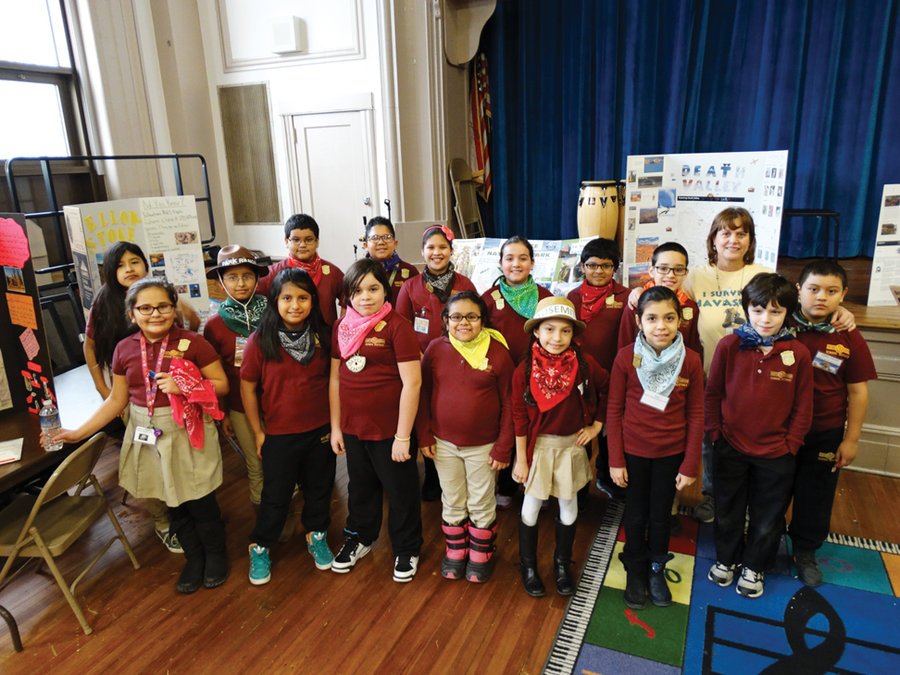Fourth grader Isabella Arias brought a piece of Death Valley to class on Friday, Jan. 30. It was the day of the National Park Fair at Franklin School in North Bergen. Isabella, in her park ranger hat and wearing a homemade I.D., exhibited a cactus she had bought online so that students at the school could get a flavor of that part of California and Nevada.
“Death Valley’s not really dangerous,” said Isabella, as students from the school examined her homemade exhibit in the auditorium. “Some people, when they got here, they heard the name ‘Death Valley,’ and they were like, ‘That’s scary.’ But there’s a lot of life there. When I was searching for a park what amazed me was the beautiful trees. When you go there at nighttime you can actually see billions and billions of stars and planets.”
Like many of the 16 students in the class, Isabella spoke animatedly about “her” park, answering questions in elaborate detail.
Victoria Spignolio waxed enthusiastic about Yellowstone National Park, explaining lesser-known facts, like it was the first national park in the country and spans three states.
“I really want to go there to try rafting,” she said. “I never tried rafting and I’ve been asking my father. He says one day we’ll drive there but he thinks I’m too young and it’s a long drive.”
Each student in the class selected five parks they would like to research and teacher Anna Pantoliano narrowed it down to one each.
“Before she picked it for me I researched it and Yellowstone was very interesting to me since I love waterfalls,” said Victoria. “I really, really, really, really, really liked this park and the plants and the animals and how beautiful it is.”
‘An impact on the rest of their lives’
“This is my last class,” said Pantoliano, who has taught since 1979 and is retiring after this year. She has been at Franklin School for over 30 years and taught fourth grade since 1985. This is the third year she has held the National Parks Fair.
“The purpose of the National Parks Fair is to involve them in a project that might have an impact on the rest of their lives,” she said. “National parks are one of my passions. The outdoors is one of my passions. Children these days spend too much time indoors. I want them to travel to the national parks as they get older. I want them to see what’s out there. And I also invite the parents to come because I want the parents to become aware of the national parks system so they don’t always just go down the shore or Disneyworld.”
“Children these days spend too much time indoors. I want them to travel to the national parks as they get older. I want them to see what’s out there.” –Anna Pantoliano
____________
Although the class couldn’t exactly take a field trip to Yellowstone or Death Valley, Pantoliano did bring them to Edison National Park in West Orange.
“They got to actually talk to a ranger and see what a ranger is,” she said. “They may not know what a park ranger does until this project. It’s a career choice that they could make in the future.”
Perhaps most important, “It gives [the students] an opportunity to speak and present,” Pantoliano said. “Which a lot of them have never done before. So it’s a wonderful experience for them.”
“I thought I would pretty much die because I’m very shy, so I was very nervous,” said Belen Hernandez. “But now that I’m doing it I feel better. I’m not panicking or anything.” In fact, after beginning by quickly reciting a list of memorized facts, Belen opened up and spoke enthusiastically about the spectacular red-orange rock formations of Bryce Canyon National Park in Utah. “You don’t see these every day. Some things you can see in other parks but these you can’t see anywhere else.”
Each student was required to create a three-panel presentation representing their park. The hand-lettered logo for Bryce Canyon reflected Belen’s interest in drawing.
In fact, each student put their own spin on the project, offering different types of presentations, some more elaborate than others. Gina DeFilippo, for example, brought in a slide projector and a laser pointer to help illustrate her points about the Grand Canyon.
Still, her presentation wasn’t quite as popular as Death Valley. Isabella, it turned out, had brought a bucket of candy in addition to her cactus.
Preserving nature
“The class wrote letters and mine was to the Rocky Mountain National Park,” explained Gaby Silva about how she collected data on her park. “And they sent me a letter with all this information. And I researched on the Internet too.”
Naomi Castellanos spoke with obvious affection for Yosemite National Park. Why Yosemite? “Because I love nature and animals and it has both those things. It’s a very beautiful park and I love the sequoias and the weird plants and animals,” she said. So has she ever been to Yosemite? “No, and I’d looove to go there.”
Some of the parks are less renowned, like Glacier Bay National Park on the Pacific coast of Alaska, established in 1980 and accessible only by ferry, according to Dhiralyn Chavez, who is concerned about the local ecosystem.
“Global warming means the heat in Alaska is getting a little bit more hot and it’s starting to melt all the ice down,” said Dhiralyn. “It affects the animals that live in the snow like the mountain goat and the seal. These animals will not survive and will die.”
Lourdes Garcia, who researched Olympic National Park in Washington, said, “I learned that national parks have so many beautiful things to do. They have events that you can go to. They have rare animals. Children need to know what national parks are and to preserve their beauty.”
Art Schwartz may be reached at arts@hudsonreporter.com.
